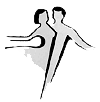 |
ROUND DANCING — CHOREOGRAPHED BALLROOMEDUCATIONAL ARTICLESMAJOR SECTIONS: Figures | Articles | Links | Alph. Index | Search | Home |
|
|
The Switch In Slow Two Stepby Harold & Meredith Sears The cue "Switch" is used in many ways in Round Dancing. Sometimes there is one step and sometimes three. Sometimes we turn left and sometimes right. Sometimes it's a very little turn and sometimes it's a half or more. But the common denominator seems to be one step in which there is a more or less dramatic change. We sharply "switch" from one position to another or from one facing direction to another. For instance, in a waltz Contra Check and Switch, we do the Contra Check (forward left for the man and back right for the woman). Then, we recover on trail feet and step back left (woman forward right) turning as a couple about 1/4 to the right.In a rumba Switch, we might have just done an Aida to a V-back-to-back position. The switch is one step back on the inside foot, turning individually to face partner. If we had done the Aida to a very strong back-to-back, this switch might turn each of us almost 1/2. We finish this figure with a recover step and then a cross in front, still facing partner. In Where Or When, by the Worlocks, there is a Promenade Weave 5 checking to a Slow Switch. Here, the Promenade Weave takes us to banjo position facing reverse, and the checking step feels like any "check and weave" sort of sequence. The switch is then just one step, forward this time, on the lead foot (back for the woman), and a sharp turn to the right, to closed position facing line. This time we turn fully 1/2 or even a little more. We then dance a Natural Weave. Switches—In slow two step, Switches are much like a progressive "man across; woman across;" or Open In and Out Runs (sqq; sqq;). We begin in half open position, facing line of dance. The man begins turning right-face and steps forward and side left, crossing in front of the woman and moving to the outside of the circle (woman forward right). He steps side and forward turning to left half open position, and then forward left. The woman takes small steps: fwd, -, fwd, fwd. In the second measure, the woman "switches" across. She steps forward and side left, crossing in front of the man and turning strongly right-face, fwd and sd R to half open position again, and finally fwd L. In this figure, the "switching" step is the first one of each measure, and the "switch" in body position is quite dramatic. In half open position, the man is facing line of dance. On that first step, he moves from the inside of the circle to the outside and turns full around, to left half open, again facing line of dance. That step has a very switchy feel. The Square—This figure, also known as a Switch Box, consists of four switches that have been modified to move the couple counterclockwise to the four sides of an imaginary square. We begin in half open position, facing line of dance. We do a Switch to left half open position facing center. Notice that the man's body-turn is less than in a standard slow-two-step Switch, about 3/4, and the woman actually turns 1/4 to the left. In the second measure, the woman switches across to half open position facing reverse, turning 3/4 to the right, and the man turns 1/4 to the left. Then we switch to left half open facing wall, and finally to half open facing line, again. Although the amount of individual turn is a little less than in standard Switches, we are still going across our partner, we are turning sharply, and as a couple we are abruptly turning, too—switchy, indeed.
A version of this article was published in the Washington Area Square Dancers Cooperative Association (WASCA) Calls 'n' Cues, 50-3:9, 11/2009; reprinted North Carolina Round Dance
Association Quarterly Newsletter, May 2012.
If you would like to read other articles on dance position, technique, styling, and specific dance rhythms, you may visit the article TOC. Past DRDC Educational Articles archived here. Go beyond this site. Find other references on our Sources and Links pages.
|
 |
|
|
Page last revised